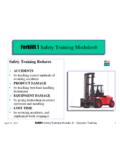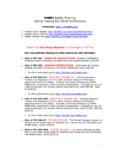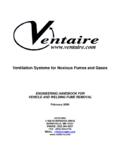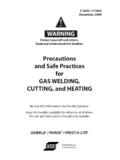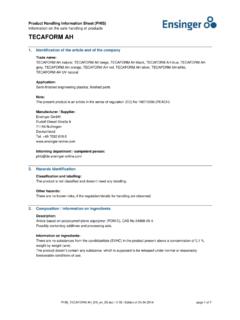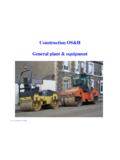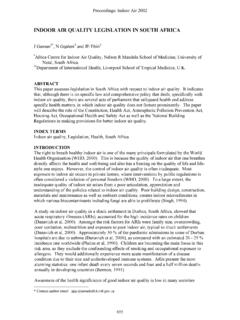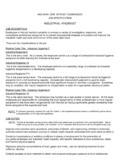Transcription of 29 CFR 1910 - Forklift1.com
1 1 Code of Federal Regulations 29 CFR (N) OSHA SAFETY TRAINING FOR OPERATORS This is the material you must study and learn to pass the OSHA Forklift Operators Written Test for OSHA Forklift Operator Certification. To take the OSHA Forklift Operator Written Test for online, go to OSHA Regulations (Standards - 29 CFR) Powered industrial trucks. - Standard Number: Standard Title: Powered Industrial Trucks. SubPart Number: N SubPart Title: Materials Handling and Storage Applicable Standard: Applicable Standard: (a) - General Requirements (b) - Designations (c) - Designated Locations (d) - Converted Trucks (e) - Safety Guards (f) - Fuel Handling & Storage (g) - Changing & Charging Storage Batteries (h) - Lighting Operations (i) - Noxious Gases & Fumes (k) - Trucks & Railroad Cars (l) - Operator Training (m) - Truck Operations (n) - Traveling (o) - Loading (p) - Operation of the Truck.
2 (m) Truck Operations. (m)(1) Trucks shall not be driven up to anyone standing in front of a bench or other fixed object. (m)(2) No person shall be allowed to stand or pass under the elevated portion of any truck, whether loaded or empty. 2 (m)(3) Unauthorized personnel shall not be permitted to ride on powered industrial trucks. A safe place to ride shall be provided where riding of trucks is authorized. (m)(4) The employer shall prohibit arms or legs from being placed between the uprights of the mast or outside the running lines of the truck. (m)(5)(i) When a powered industrial truck is left unattended, load engaging means shall be fully lowered, controls shall be neutralized, power shall be shut off, and brakes set. Wheels shall be blocked if the truck is parked on an incline.
3 (m)(5)(ii) A powered industrial truck is unattended when the operator is 25 ft. or more away from the vehicle which remains in his view, or whenever the operator leaves the vehicle and it is not in his view.. (m)(5)(iii) When the operator of an industrial truck is dismounted and within 25 ft. of the truck still in his view, the load engaging means shall be fully lowered, controls neutralized, and the brakes set to prevent movement. (m)(6) A safe distance shall be maintained from the edge of ramps or platforms while on any elevated dock, or platform or freight car. Trucks shall not be used for opening or closing freight doors. (m)(7) Brakes shall be set and wheel blocks shall be in place to prevent movement of trucks, trailers, or railroad cars while loading or unloading. Fixed jacks may be necessary to support a semitrailer during loading or unloading when the trailer is not coupled to a tractor.
4 The flooring of trucks, trailers, and railroad cars shall be checked for breaks and weakness before they are driven onto. (m)(8) There shall be sufficient headroom under overhead installations, lights, pipes, sprinkler system, etc. (m)(9) An overhead guard shall be used as protection against falling objects. It should be noted that an overhead guard is intended to offer protection from the impact of small packages, boxes, bagged material, etc., representative of the job application, but not to withstand the impact of a falling capacity load. (m)(10) A load backrest extension shall be used whenever necessary to minimize the possibility of the load or part of it from falling rearward.. (m)(11) Only approved industrial trucks shall be used in hazardous locations. (m)(12) Whenever a truck is equipped with vertical only, or vertical and horizontal controls elevatable with the lifting carriage or forks for lifting personnel, the following additional precautions shall be taken for the protection of personnel being elevated.
5 3 (m)(12)(i) Use of a safety platform firmly secured to the lifting carriage and/or forks. (m)(12)(ii) Means shall be provided whereby personnel on the platform can shut off power to the truck. (m)(12)(iii) Such protection from falling objects as indicated necessary by the operating conditions shall be provided. (m)(14) Fire aisles, access to stairways, and fire equipment shall be kept clear.. (n) Traveling. (n)(1) All traffic regulations shall be observed, including authorized plant speed limits. A safe distance shall be maintained approximately three truck lengths from the truck ahead, and the truck shall be kept under control at all times. (n)(2) The right of way shall be yielded to ambulances, fire trucks, or other vehicles in emergency situations. (n)(3) Other trucks traveling in the same direction at intersections, blind spots, or other dangerous locations shall not be passed.
6 (n)(4) The driver shall be required to slow down and sound the horn at cross aisles and other locations where vision is obstructed. If the load being carried obstructs forward view, the driver shall be required to travel with the load trailing. (n)(5) Railroad tracks shall be crossed diagonally wherever possible. Parking closer than 8 feet from the center of railroad tracks is prohibited. (n)(6) The driver shall be required to look in the direction of, and keep a clear view of the path of travel. (n)(7) Grades shall be ascended or descended slowly. (n)(7)(i) When ascending or descending grades in excess of 10 percent, loaded trucks shall be driven with the load upgrade.. (n)(7)(iii) On all grades the load and load engaging means shall be tilted back if applicable, and raised only as far as necessary to clear the road surface.
7 (n)(8) Under all travel conditions the truck shall be operated at a speed that will permit it to be brought to a stop in a safe manner. (n)(9) Stunt driving and horseplay shall not be permitted. (n)(10) The driver shall be required to slow down for wet and slippery floors. 4 (n)(11) Dockboard or bridgeplates, shall be properly secured before they are driven over. Dockboard or bridgeplates shall be driven over carefully and slowly and their rated capacity never exceeded. (n)(12) Elevators shall be approached slowly, and then entered squarely after the elevator car is properly leveled. Once on the elevator, the controls shall be neutralized, power shut off, and the brakes set. (n)(13) Motorized hand trucks must enter elevator or other confined areas with load end forward.. (n)(14) Running over loose objects on the roadway surface shall be avoided.
8 (n)(15) While negotiating turns, speed shall be reduced to a safe level by means of turning the hand steering wheel in a smooth, sweeping motion. Except when maneuvering at a very low speed, the hand steering wheel shall be turned at a moderate, even rate.. (o) Loading. (o)(1) Only stable or safely arranged loads shall be handled. Caution shall be exercised when handling off-center loads which cannot be centered. (o)(2) Only loads within the rated capacity of the truck shall be handled. (o)(3) The long or high (including multiple-tiered) loads which may affect capacity shall be adjusted. (o)(4) Trucks equipped with attachments shall be operated as partially loaded trucks when not handling a load. (o)(5) A load engaging means shall be placed under the load as far as possible; the mast shall be carefully tilted backward to stabilize the load.
9 (o)(6) Extreme care shall be used when tilting the load forward or backward, particularly when high tiering. Tilting forward with load engaging means elevated shall be prohibited except to pick up a load. An elevated load shall not be tilted forward except when the load is in a deposit position over a rack or stack. When stacking or tiering, only enough backward tilt to stabilize the load shall be used.. (p) Operation of the Truck. (p)(1) If at any time a powered industrial truck is found to be in need of repair, defective, or in any way unsafe, the truck shall be taken out of service until it has been restored to safe operating condition. 5 (p)(2) Fuel tanks shall not be filled while the engine is running. Spillage shall be avoided. (p)(3) Spillage of oil or fuel shall be carefully washed away or completely evaporated and the fuel tank cap replaced before restarting engine.
10 (p)(4) No truck shall be operated with a leak in the fuel system until the leak has been corrected. (p)(5) Open flames shall not be used for checking electrolyte level in storage batteries or gasoline level in fuel tanks.. (q) Maintenance of Industrial Trucks. (q)(1) Any power-operated industrial truck not in safe operating condition shall be removed from service. All repairs shall be made by authorized personnel.. (q)(2) No repairs shall be made in Class I, II, and III locations. (q)(3) Those repairs to the fuel and ignition systems of industrial trucks which involve fire hazards shall be conducted only in locations designated for such repairs. (q)(4) Trucks in need of repairs to the electrical system shall have the battery disconnected prior to such repairs. (q)(5) All parts of any such industrial truck requiring replacement shall be replaced only by parts equivalent as to safety with those used in the original design.
